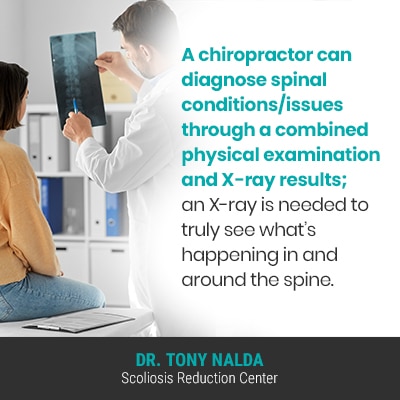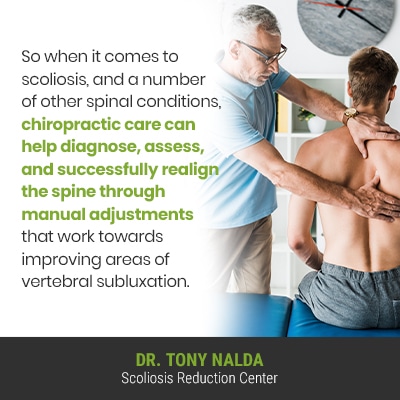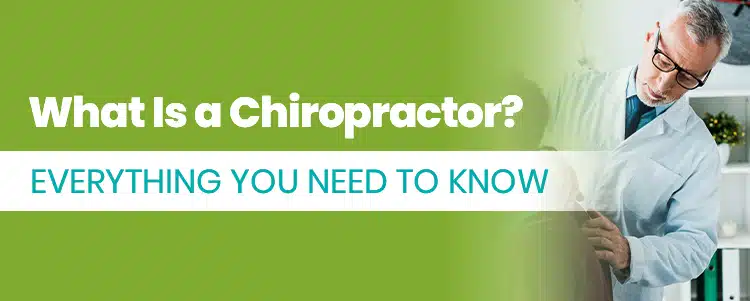A chiropractor can help diagnose, assess, and address issues related to misaligned joints, particularly those in the spine. When the spine’s vertebrae (bones) aren’t stacked on top of one another in a straight and neutral alignment, the biomechanics of the entire spine are disrupted, and this can cause a number of symptoms.
A chiropractor is a healthcare professional trained and certified in chiropractic: a branch of medicine that focuses on assessing and diagnosing conditions related to misaligned joints. Through manipulating and adjusting the position of specific vertebrae, a misaligned spine can be addressed.
A chiropractor can help with musculoskeletal issues related to a misaligned spine, so let’s start with the importance of a healthy spine.
Spinal Health and Function
The spine is a key structure of human anatomy; it helps us to stand upright, practice good posture, move flexibly, and the spinal cord within works in tandem with the brain to form the body’s central nervous system (CNS).
The spine is naturally curved at each of its main sections: the cervical spine (neck), thoracic spine (middle/upper back), and the lumbar spine (lower back).
If the spine’s natural and healthy curves are in place, it’s stronger, more flexible, and better able to handle mechanical stress incurred during activity.
If the spine’s natural and healthy curves are in place, its vertebrae (bones of the spine) are stacked on top of one another in a straight and neutral alignment.
An intervertebral disc sits between each pair of adjacent vertebrae and performs many key functions: the discs give the spine structure (adjacent vertebrae attach to the disc in between), provide cushioning between adjacent vertebrae, act as the spine’s shock absorbers, and combine forces to facilitate flexible movement.
In many cases of spinal degeneration, it’s the discs that are the first spinal structures to feel the effects of degeneration, so their health is key to overall spinal health; if a disc degenerates, becomes desiccated, and changes shape as a result, it affects the position of adjacent vertebrae attached, and can introduce uneven pressure to the affected disc’s surroundings, including nearby spinal nerves.
So if the spine’s discs are healthy and its vertebrae are aligned, the spine can function as it was designed, but if one or more of those vertebral bodies become excessively tilted and shift out of alignment with the rest of the spine, chiropractic care can help.
How Chiropractic Can Help
When a spine becomes misaligned, its vertebrae aren’t stacked on top of one another as they should be, and this disrupts the biomechanics of the entire spine.
When a spine is misaligned, it can have a number of causes from an injury or trauma to postural issues and the presence of an underlying spinal condition.
Whatever the cause of a spinal issue/condition, the underlying cause has to be the focus of treatment, and chiropractors know the spine, and they know how it’s affected by a number of injuries, lifestyle choices, and conditions.

A chiropractor can diagnose spinal conditions/issues through a combined physical examination and X-ray results; an X-ray is needed to truly see what’s happening in and around the spine.
With an X-ray, we can see if the spine is misaligned, where the affected vertebrae are, how its surroundings are affected, and diagnose its cause.
As a chiropractor, I’m aware of the close connection between spinal health and function and nervous system activity; spinal biomechanics and structural changes within the spine can impact the nervous system because of the 31 pairs of spinal nerves contained within.
In a number of conditions, restoring the spine’s structural integrity means taking pressure off spinal nerves and neurological tissue, and thereby improving a patient’s health and wellness.
The underpinning of chiropractic is to improve spinal mobility, reducing irritation on affected spinal nerves and improving related symptoms.
Chiropractors can also have a specialty; for example, as a CLEAR-certified scoliosis chiropractor, I focus on how to restore a scoliotic spine’s natural curves, alignment, and address areas of vertebral subluxation through non-invasive condition-specific chiropractic treatment.
Chiropractic and Scoliosis
The main reason people seek help from chiropractors is back pain, and back pain can be caused by a number of variables: lifestyle choices, injury, and/or the presence of an underlying spinal condition like scoliosis.
Scoliosis is a highly-prevalent structural spinal condition; the Scoliosis Research Society has current estimates at close to seven million people currently living with scoliosis in the United States alone, and it’s the leading spinal condition amongst school-aged children.
While traditional scoliosis treatment doesn’t involve chiropractic care and funnels patients towards invasive spinal surgery, a chiropractic-centered treatment approach offers patients a less risky, costly, and invasive non-surgical treatment alternative.
Here at the Scoliosis Reduction Center®, my patients benefit from a conservative treatment approach that integrates multiple condition-specific treatment disciplines so conditions can be impacted on every level: chiropractic care, physical therapy, corrective bracing, and rehabilitation.
With scoliosis, an unnatural sideways-bending and rotating spinal curvature has developed, and scoliosis is a structural spinal condition, meaning it involves a structural abnormality within the spine itself.
When a condition is structural, no change to posture or position will impact the unnatural curve, and that’s why scoliosis treatment has to, first and foremost, impact it on a structural level, and this is where chiropractic care comes in.
Chiropractic Care and Healthy Spinal Curves
In scoliosis, one or more vertebrae have become excessively tilted, shifting their position out of alignment with the rest of the spine, disrupting the biomechanics of the entire spine.

Through a series of complex measurements taken during a scoliosis X-ray, I learn what I need to know about what’s happening in and around the spine and customize treatment plans to work towards condition improvement.
Firstly, I use a series of chiropractic techniques and manual adjustments to work towards repositioning the most-tilted vertebrae at the curve’s apex back into alignment with the rest of the spine.
When the spine has an unnatural spinal curve, it doesn’t just affect the spine, but also its surroundings, including nearby muscles and nerves.
When the spine becomes misaligned, certain vertebral bodies have changed their position, and this means they are taking up space, or putting pressure, on areas where they weren’t before, when the spine was aligned as it was designed.
If vertebral bodies are adjusted back into alignment with the rest of the spine, the structural nature of the condition is being addressed, and this also relieves pressure on the affected surroundings, and relieving spinal nerves and muscles from compression can mean restoring their health and function, as well as the spine’s.
Once I start to see structural results through chiropractic care, I can shift the focus to physical therapy and increasing core strength so the spine’s surrounding muscles can optimally support it.
Corrective bracing can help by pushing the spine into a corrective position, and rehabilitation can involve a series of custom-prescribed exercises that patients can easily perform from home to further stabilize and heal their spines.
So when it comes to scoliosis, and a number of other spinal conditions, chiropractic care can help diagnose, assess, and successfully realign the spine through manual adjustments that work towards improving areas of vertebral subluxation.
Conclusion
My journey with chiropractic has been personal and started as an adolescent with chronic and debilitating migraines.
After trying a number of medications and treatments, chiropractic care was the only form of treatment that helped, and it made me realize its power to improve so many aspects of spinal health, and life in general; from there, I chose to focus on scoliosis because I saw a gap in effective treatment options that didn’t involve invasive, costly, and risky spinal fusion surgery.
The very design of the spine is based on movement, so it’s important to keep the spine as strong, loose, and flexible as possible, and this requires leading a spine-friendly lifestyle: maintaining a healthy weight, activity level, practicing good posture, lifting heavy objects correctly, and refraining from excessive consumption of alcohol and/or smoking.
There is a certain amount of spinal degeneration to be expected with age, but the aforementioned lifestyle factors help shape a person’s level and rate of natural age-related spinal degeneration.
Chiropractors know the spine, and they know how it’s affected by a number of issues, injuries, and spinal conditions, and they can help assess and improve the health and function of the spine through focusing on how it’s aligned.
When it comes to spinal conditions like scoliosis, as a scoliosis chiropractor, I can diagnose, assess, and treat conditions effectively, proving that many cases of scoliosis don’t require surgical treatment.
Proactive chiropractic care can help patients avoid the risks associated with invasive spinal surgery, and traditional scoliosis treatment that offers spinal fusion does so without first attempting less-invasive treatment methods.
So what you need to know about chiropractic care is that it can help preserve natural spinal strength and function by focusing on how the spine’s vertebrae and joints are aligned.




